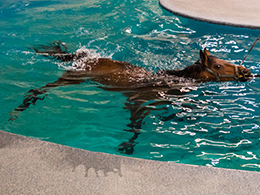
What is horse hydrotherapy, and how is it useful?
Equine hydrotherapy isn’t just for top competition horses – it can be a great way to improve fitness and build muscle, especially after an injury. We spoke to Petplan Equine veterinary expert Gil Riley to find out more.
Horse hydrotherapy treatments can be used to relieve pain and build fitness. There are four types of equine hydrotherapy: swimming, which can help horse rehabilitation after injuries such as ligament damage; water treadmills, which can improve a horse’s range of movement; equine spas, where the low water temperature can reduce inflammation; and cold hosing, which helps stop fluid building up and provides pain relief.
Petplan Equine vet Gil Riley explains: ‘Swimming is excellent for building a horse’s stamina, whether the horse is fit and well or under rehab. It’s low-impact, which helps protects fragile limbs, and makes the practice popular for racehorses.’
How does horse hydrotherapy work?
Kerry-Anne Bourne, Assistant Manager at Hartpury Equine Therapy Centre, explains what a session on their water treadmill entails: ‘Horses will have a maximum 20-minute session. Two people hold the horse and another person drives, which allows the horse to stay straight while walking. The horses have their tails wrapped with a tail guard to keep it out of the water. From unloading to loading the whole process takes half an hour.’
Being put in a dry treadmill first, horses are introduced to water treadmills gradually. The water is built up over a period of time and the depth used depends on the type of work required and the horse’s height.
‘Being in a water treadmill encourages a horse to sit back more, taking weight off his forelimbs. He’ll take bigger steps in the water than he would on land, and experience resistance from the water, resulting in longer and less frequent movements and a low-intensity work out. The practice is good for back and pelvic injuries as well as synovitis (inflammation of the membrane in joints).’
Horses are encouraged to start swimming gradually, first going in straight lines on the treadmill. Once they are comfortable with the water, they can be taken off of the treadmill to swim around the pool in an oval shape – which is harder for the horse, though he learns quickly. He will have to hold his head up, which also builds his neck muscles.
‘A horse swimming eight laps of an oval pool to the left and then the same to the right will develop as much fitness as going for two brisk canters,’ says Gil.
What can you expect from hydrotherapy treatment?
Horses can go to a centre like Hartpury for individual sessions, or can be on therapy livery.
‘We’ve had horses here for anything from a week to 18 months,’ says Kerry-Anne. ‘We’ll formulate a weekly progress plan for each horse and go from there. Horses can have sessions without a vet referral. But if needed, we would contact the vet to understand the horse’s condition to ensure treatment was appropriate if relating to an injury.
‘We have horses being treated for tendon injuries, front feet issues and ligament problems,’ adds Kerry-Anne, who also sees a lot of healthy sport horses for fitness work. ‘Dressage horses come for pre-event work and eventers for post-event work. For the horse to work without a rider, it’s like going to the gym to get fit for your sport without the specific strain that sport would put on you.
‘Riders say that their horses feel fitter, go straighter and are more relaxed and suppler after water treadmill therapy. We treat top sports horses and happy hackers, and it can just be part of the horse’s week – something else for them to do. And it can help keep a horse fit when a rider is injured, too.’
What’s a static spa?
Static spas have a still floor, unlike the moving treadmills, but again the horse will walk into the dry structure before it’s gradually filled with water. Spas are filled with cold water, between 2°C and 4°C, that has a higher salt content than the sea. Jets may also be used – as you would find in a Jacuzzi.
‘This treatment numbs the limbs and acts like a poultice, so is good for wounds and tackling inflammation,’ explains Gil. ‘Because the treatment is drug-free, it can be ideal for horses competing in events for which certain medicines are banned. Horses with laminitis can respond well to the lower temperature treatment, too.’
How can cold hosing help?
Gil adds that cold hosing is a method of DIY cold water therapy for horses that doesn’t require them to be transported to a treatment centre. ‘Cold hosing can help with leg injuries, providing numbing and pain relief and preventing fluid build-up,’ he says.
‘A tendon injury might take a year to heal, for example, but cold hosing in the first hours after the injury has occurred can help minimise the damage to the tendon caused by acute inflammation. A horse’s leg should only be cold hosed for five minutes at a time, every 30 minutes, to avoid issues with poor circulation.’
Does insurance cover hydrotherapy?
If your horse is receiving hydrotherapy treatment carried out by a vet, or following a veterinary referral, then you can claim back the cost of this under your Petplan insurance. However, if your horse undergoes any treatment that has not been approved by a vet then, unfortunately, this won’t be covered. Check your policy for further details before taking your horse for treatment*.
*T&Cs apply


